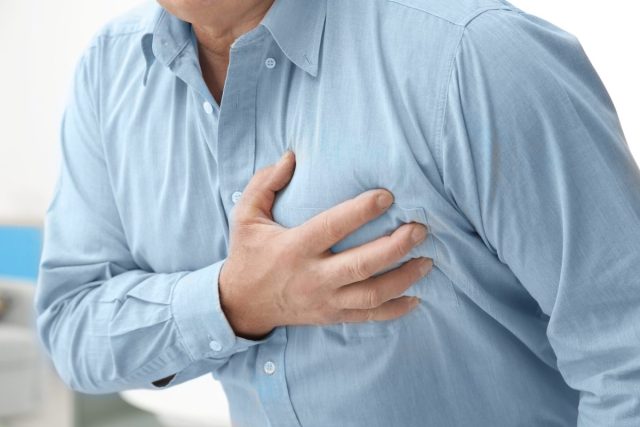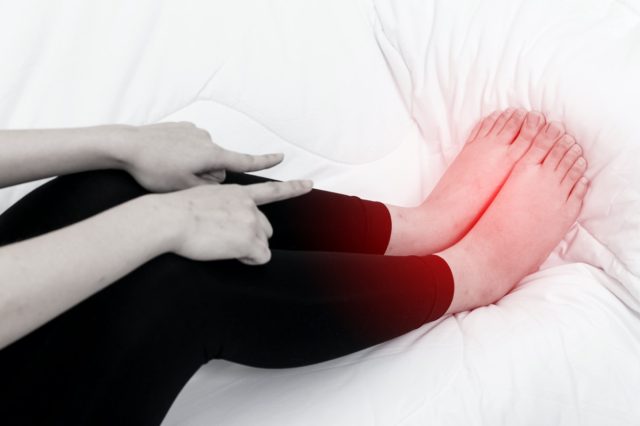Heart disease remains the leading cause of death in the United States and while we'd all like to think we would know if there's a problem with our heart, oftentimes there aren't warning signs. And when there are indications of a problem, frequently the symptoms are dismissed or overlooked because they have nothing to do with the heart. "Warning signs can appear on your skin and nails, which is why your dermatologist may be the first doctor to notice that you have heart disease. If you know what to look for, you can also find warning signs of heart disease on your skin and nails," The American Academy of Dermatologist Association states.
According to the Centers for Disease Control and Prevention, "One person dies every 34 seconds in the United States from cardiovascular disease. About 697,000 people in the United States died from heart disease in 2020—that's 1 in every 5 deaths." While heart disease is common, it's not inevitable. Many cases are avoidable.
The Cleveland Center says, "Heart disease is 90 percent treatable – everyone can prevent heart disease anywhere in the world, especially by eating foods that are low in salt and cholesterol, exercising regularly, and not smoking," said Leslie Cho, M.D., Section Head for Preventive Cardiology and Cardiac Rehabilitation at Cleveland Clinic. "Even if a person has a family history of heart disease, we can still prevent and treat heart disease thanks to incredible advances in medicine." Recognizing the early signs of heart disease can save your life and Eat This, Not That! Health spoke with experts who share what to know about the No. 1 killer and symptoms to not ignore. As always, please speak to your physician for medical advice.
Why Heart Disease is the Leading Cause of Death When Many Cases are Preventable

Eric Stahl, MD Non-Invasive Cardiologist at Staten Island University Hospital tells us, "The most common type of heart disease is coronary artery disease, which is most often caused by atherosclerosis. Atherosclerosis is the process by which fatty plaque builds up in the walls of the arteries, which ultimately leads to narrowing of the blood vessels. Atherosclerosis developps from high cholesterol, smoking, high blood pressure, diabetes, obesity, lack of exercise or poor diet. Although these risk factors are preventable, they remain prevalent in the USA."
Dr. Jacob Hascalovici MD, PhD and Clearing Chief Medical Officer explains, "Many of the risks that contribute to getting heart disease are cut when people change their behaviors. Quitting or avoiding smoking, lowering cholesterol, controlling high blood pressure, preventing obesity, and managing type 2 diabetes are all behaviors many people can personally influence through their eating, exercise, and stress management habits. It's not always easy to change one's behavior though – habits like eating and exercise can be deeply shaped by family, friends, culture, and one's surroundings. Both social and individual changes could successfully prevent more deaths from heart disease, so it's up to all of us working together to prevent heart disease."
What to Know About Heart Disease

Dr. Stahl says, "Heart disease is the leading cause of death in the USA. Within heart disease, coronary artery disease due to atherosclerosis is most common. The process of atherosclerosis starts in the second and third decade of life as a result of high cholesterol, smoking, high blood pressure, diabetes, obesity, lack of exercise or poor diet."
Dr. Hascalovici adds, "People should know that heart disease can, in fact, be avoided, and that many of the ways to avoid it can be personally controlled. For a healthy heart, I recommend these lifestyle tips:
- Stay connected with people (or pets!) who make you feel better. That keeps loneliness at bay and helps you release heart-healthy endorphins
- Swim, stretch, do tai chi or yoga, or simply have a long walk once a day at least five times a week. While vigorous exercise is great, too, these calming pursuits are also great for your heart while being soothing for your joints and mind.
- Stress management is key. You can get there by both reducing your levels of stress and by promoting things that bring you more happiness. Pick a mindfulness habit that appeals to you, and make sure what you're engaging with helps you feel inspired, intrigued or happier, instead of stressing you more.
- Get your 7-8 hours of sleep a night, no questions asked.
- Learn to use your vagus nerve to help calm your heart rate by mastering deep breathing techniques and rhythms.
- Eat to reduce inflammation. I recommend trying a Mediterranean diet, for example.
- Set goals to make your heart happier, making sure each goal is a SMART (Specific, Measurable, Attainable, Relevant and Time-Based) one. For example, you may decide to switch from cooking with cream to olive oil. Or you may add a 20-minute walk, a 10-minute set of weight-based exercise, or a once-a-week "exercise date" with a friend to play tennis, swim, or do another activity you find enjoyable and easy to keep doing. Once you succeed at this goal, add another one, or make the first goal a little tougher. Slow and steady wins the resolution race!"
Many Cases of Heart Disease are Treatable

According to Dr. Stahl, "Heart disease, particularly the most common coronary artery disease due to atherosclerosis, is often preventable if detected early. For most patients, high cholesterol, smoking, diabetes, obesity, lack of exercise and poor diet contribute to developing heart disease. It is important to get regular blood pressure, cholesterol and diabetes screening. Everyone over the age of 20 should undergo screening at least every 5 years. Screening and treating its risk factors is the best way to prevent heart disease from developing."
Dr. Hascalovici explains, "Heart disease can be quite treatable, particularly when it's caught early. Many of those treatments involve making manageable behavioral changes that lower cholesterol and blood pressure. Early indicators of heart disease include a number of signs, many of them involving pain and pressure in your chest or arms."
Heart Disease Signs That can Appear Early

Dr. Stahl tells us, "Heart disease most commonly presents with chest pain, shortness of breath, or swelling due to fluid retention. If someone starts experiencing these symptoms, they should discuss it with their primary care doctor or cardiologist. Unfortunately, signs and symptoms of heart disease can be vague. In addition to more classic symptoms, patients sometimes present with fatigue, indigestion, back or neck pain, or nausea. It is important to seek medical care if these symptoms develop."
Dr. Hascalovici says, "Unusual pain, like pain in your back, jaw, or abdomen, can signal heart disease. Shortness of breath and numb or cold-feeling limbs that don't seem as strong as usual are other signs. Tightness, pressure, and pain in your chest region should not be ignored. If you notice these indicators, get an appointment with your physician, who can help set up the scans and tests you may need to check for heart disease. It's always a good idea to have a strong behavioral foundation consisting of low-fat, healthy eating and regular movement."
Heart Disease Signs that Appear on Your Skin and Nails

According to the American Academy of Dermatologist Association, there are many signs of heart disease that can appear on your skin and nails. Many people don't realize these are warning signals for the leading cause of death and they're often ignored. Here's 12 signs to be aware of.
–"Swelling in your feet and lower legs. What it may be telling you: Your heart isn't working properly.
–Blue or purple color on your skin. What it may be telling you: You have a blockage in a blood vessel.
–Blue or purple net-like pattern on your skin. What it may be telling you: You have a blocked artery.
–Yellowish-orange, waxy growths on your skin. What it may be telling you: You have unhealthy cholesterol levels.
–Clusters of waxy bumps that suddenly appear on your skin. What it may be telling you: You have skyrocketing cholesterol levels or diabetes.
–Clubbing causes nails to curve down. What it may be telling you: You may have a heart infection, heart disease, or lung problem.
–Red or purple lines under your nails. What it may be telling you: Most people who see these lines under their nails have injured the nail in some way. If you cannot remember injuring your nail, you may want to see your doctor. These lines can be a sign of heart disease or another condition. When it's a sign of heart disease, people tend to have symptoms, such as high fever and a weak or irregular heartbeat.
–Smooth, waxy lumps on your skin. Nodules of systemic amyloidosis on fingers. What it may be telling you: You have protein deposits in your heart or another organ.
–Painful lumps in your fingers, toes, or both. Painful lumps on toes are called Osler nodes. What it may be telling you: You have an infection in your heart or blood vessels.
–Brownish (or reddish) discoloration, usually on your sole(s) or palm(s). Brown discolorations on the bottom of the foot are Janeway lesions. What it may be telling you: You have an infection in your heart or blood vessel.
–Erythema marginatum red rash. What it may be telling you: You have rheumatic fever.
–Rash and cracked, swollen lips that often bleed. Child with a rash, fever, and extremely dry lips. What it may be telling you: A child has Kawasaki disease."
There can be a Difference in Women's Symptoms for Heart Disease

Dr. Hascalovici states, "Women can have classic signs of heart disease like chest pressure or pain, too, but may also have trouble taking a deep breath, may get indigestion, may feel dizzy or nauseated, and are more likely to feel back pain."
Dr. Stahl shares, "The traditional risk factors for heart disease affect both men and women, but there are slight differences. Obesity and sedentary lifestyle are more common in women. Women with diabetes are more likely to develop cardiovascular disease, compared to their men with diabetes. Over the age of 60, uncontrolled hypertension is more prevalent in women than in men. Pregnancy complications, menopause, and oral contraceptives have also been associated with higher risk of heart disease. If they experience heart disease, women are more likely than men to have either no symptoms or atypical symptoms, such as dull pain, indigestion, fatigue, or nausea."
According to Yale Medicine, "You can get the shortness of breath or the nausea without the chest discomfort," says Lisa Freed, MD, director of the Women's Heart and Vascular Program, a part of Yale Medicine's Heart and Vascular Center. "Or you can get chest discomfort at times of extreme emotional stress, or chest discomfort that wakes you up in the middle of the night."
Women are also more likely to feel sharp, burning pain in their chest, and to have pain in the neck, jaw, throat, stomach, or back. These are called "atypical symptoms".
Yale Medicine says, " Some risk factors for heart disease can't be controlled, but many of them can be kept in check with diet, exercise, medication (if needed), and a healthy lifestyle.
Common risk factors for women include:
–High blood pressure
–High cholesterol
–A sedentary lifestyle
–Being overweight or obese
–A family history of heart attacks or heart disease
–Age (The older you are, the higher your risk. However, women generally develop coronary artery disease 10 years later in life than men, unless they have diabetes.)
–Cigarette smoking
That final risk factor, cigarette smoking, is an even bigger danger to women than men—especially to young women. "A pre-menopausal woman who smokes is at a significantly increased risk for a heart attack," says Dr. Freed. It's also important to note that type 2 diabetes is considered an indicator of the presence of underlying cardiovascular disease. It is thought that if a woman has diabetes before menopause, it strips away the 10-year advantage that women have over men with respect to coronary artery disease."